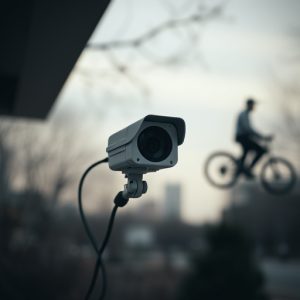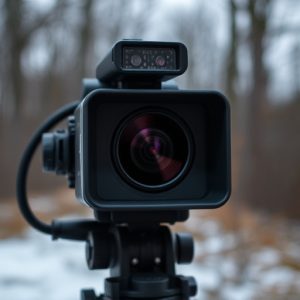Wireless Spy Camera Detection: Cloud Storage, Tips & Legal Guide
Wireless spy cameras leveraging Wi-Fi or Bluetooth transmit video feeds to smartphones or computers…….
Wireless spy cameras leveraging Wi-Fi or Bluetooth transmit video feeds to smartphones or computers for real-time monitoring, with a key advantage being cloud storage for footage. This eliminates local memory card needs and enables secure, remote access from anywhere with an internet connection. Cloud storage is a game-changer, facilitating efficient organization and retrieval of large data volumes generated by hidden surveillance devices. Advanced techniques like image forensics and radio frequency analysis help detect and locate these cameras, enhancing privacy protection. Regular visual inspections, technological tools, and vigilance against unusual network activities are crucial for detection. Legal and ethical considerations regarding consent and data security are vital to ensure minimal privacy intrusion while maintaining compliance.
“Uncover the hidden eye: A comprehensive guide to identifying covert recording spots. In today’s digital age, wireless spy cameras have evolved into sophisticated tools, often used for malicious purposes. This article delves into the world of these concealed devices, offering a detailed overview of understanding and detecting Wireless Spy Cameras. From cloud storage techniques facilitating spot identification to advanced methods and practical tips in diverse settings, we explore every angle. Additionally, legal and ethical considerations highlight the complexities surrounding covert recordings.”
- Understanding Wireless Spy Cameras: A Comprehensive Overview
- The Role of Cloud Storage in Covert Recording Spot Identification
- Advanced Methods for Uncovering Hidden Camera Locations
- Practical Tips for Detecting covert Recording Devices in Everyday Environments
- Legal and Ethical Considerations: Navigating the Complexities of Covert Recordings
Understanding Wireless Spy Cameras: A Comprehensive Overview
Wireless spy cameras have revolutionized surveillance, offering a level of discreetness and accessibility never before seen in traditional camera systems. These devices typically utilize Wi-Fi or Bluetooth technology to transmit video feeds directly to a user’s smartphone or computer, making real-time monitoring effortless. One of the key advantages lies in their ability to store footage in cloud storage, eliminating the need for physical memory cards. This feature ensures that videos are easily accessible from anywhere with an internet connection, allowing users to review captured moments at their convenience.
The integration of wireless spy cameras and cloud storage provides a sophisticated security solution. Users can remotely monitor live feeds or access recorded footage without worrying about losing data due to full local storage capacity. Additionally, cloud storage offers enhanced security through encryption, ensuring that only authorized individuals with the correct login details can view sensitive material.
The Role of Cloud Storage in Covert Recording Spot Identification
In the realm of covert recording, particularly with the proliferation of wireless spy cameras, cloud storage plays a pivotal role in spot identification and evidence retrieval. By seamlessly integrating with these hidden surveillance devices, cloud-based systems offer a secure and efficient means to store and access recorded footage. This is especially crucial for individuals or organizations seeking discreet monitoring solutions, ensuring that captured data remains safe and readily available.
Wireless spy cameras, often equipped with advanced features like motion detection and real-time transmission, generate vast amounts of data. Cloud storage acts as a centralized hub, facilitating easy organization and retrieval of these recordings. This is particularly beneficial in complex scenarios where multiple devices are deployed, allowing users to identify specific recording spots by simply accessing their cloud account from anywhere, at any time.
Advanced Methods for Uncovering Hidden Camera Locations
In the quest to uncover hidden surveillance, advanced methods have emerged to combat the use of wireless spy cameras and their reliance on cloud storage. One powerful technique involves utilizing specialized detection software that can analyze visual data for anomalies—a process known as image forensics. This technology employs sophisticated algorithms to identify subtle patterns often left behind by covert recording devices, such as unique pixel arrangements or distortion around the camera’s field of view.
Additionally, advanced signal detection techniques have been developed to pinpoint wireless spy cameras. These methods leverage radio frequency (RF) analysis, capable of detecting and tracking signals emitted by hidden cameras’ transmitters. By monitoring these signals, experts can triangulate the location of the device, providing valuable insights into where these covert recorders might be hidden. This approach is particularly effective in high-risk scenarios, ensuring that privacy invasions are swiftly and accurately addressed.
Practical Tips for Detecting covert Recording Devices in Everyday Environments
Detecting covert recording devices, such as wireless spy cameras, in everyday environments requires a blend of technological savvy and keen observation. Start by conducting regular visual inspections, paying close attention to areas that might offer hidden spots for such devices, like corners, ceiling junctions, or behind furniture. Advanced users can leverage dedicated detection apps or handheld scanners that can identify wireless signals, including those from hidden cameras and micro-microphones.
Additionally, be wary of unusual network activities. If you notice unfamiliar devices connected to your Wi-Fi network or unexplained data usage, it could indicate the presence of a covert recording device utilizing cloud storage for its recordings. Regularly update your firmware and security software, as outdated systems may have vulnerabilities that can be exploited by these devices. Keeping an eye on physical and digital anomalies can help you identify and mitigate potential threats from covert recording devices.
Legal and Ethical Considerations: Navigating the Complexities of Covert Recordings
In the realm of covert recording, understanding legal and ethical boundaries is paramount to avoid fraught circumstances. While wireless spy cameras offer valuable insights in various scenarios—from home security to professional surveillance—their deployment raises significant concerns regarding privacy and consent. Many jurisdictions have strict regulations on audio and visual recordings, especially when conducted without explicit knowledge or permission of the individuals involved.
The use of cloud storage for such recordings further complicates matters, as it introduces potential data breaches and unauthorized access. It’s crucial to consider the nature of information captured, its intended use, and whether all parties involved are aware of the recording process. Ethical guidelines suggest transparency in surveillance practices, ensuring minimal intrusion on privacy while achieving legitimate objectives. Adhering to these considerations is essential for maintaining legal compliance and fostering trust among individuals under observation.
In conclusion, understanding wireless spy cameras and their sophisticated methods, coupled with leveraging cloud storage technology, enables effective covert recording spot identification. Advanced techniques and practical tips provide a robust toolkit for detecting hidden camera locations in diverse settings. However, it’s imperative to balance these capabilities with legal and ethical considerations, ensuring responsible use in today’s digital landscape. By staying informed and adhering to the complexities of covert recordings, individuals can protect their privacy while navigating this modern challenge.


